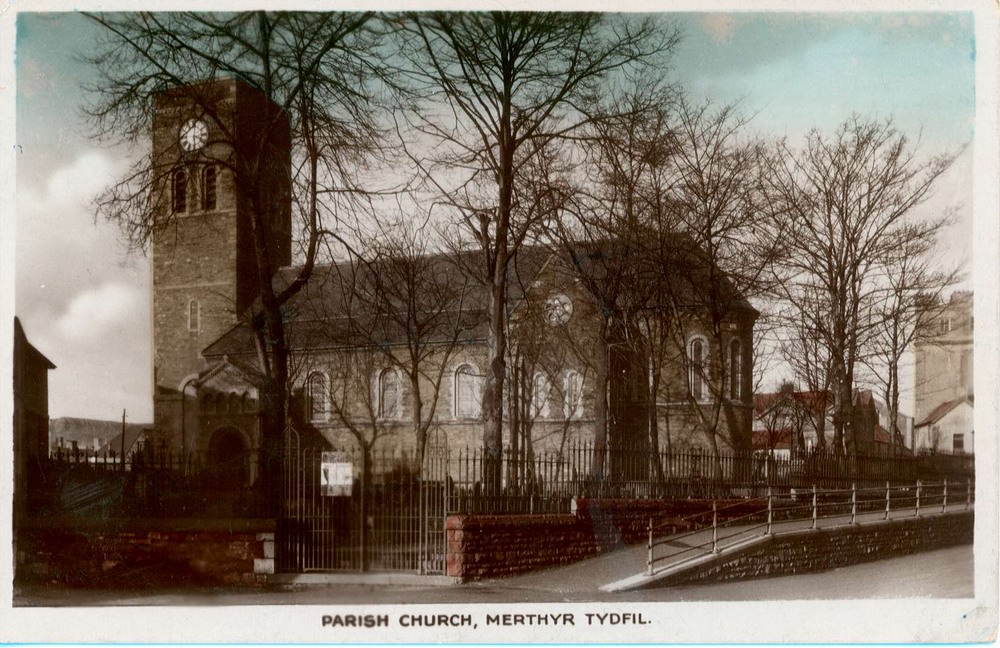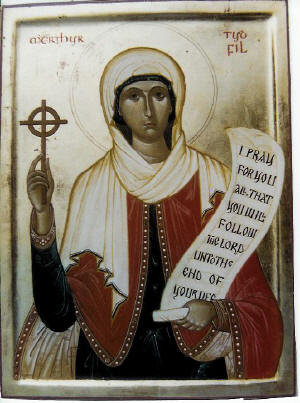SAINT TYDFIL - Tydfil
gave her name to Merthyr Tydfil (Merthyr meaning martyr in the
Welsh language). Her martyrdom took place during a pitched
battle between her family and a band of marauding Picts during
the fifth century AD. Although much of what is known about her
comes from monks writing long after she was supposed to have
lived, evidence shows that she did exist and that she did
meet with a violent end.
Tydfil was the
daughter of King Brychan, the half-Irish, half-Welsh ruler of
Garth Madry (Brecon today). Brychan had four wives and several
concubines and was said to have had 11 sons and 25 daughters.
Tydfil was his 23rd daughter by his fourth wife. Most of
Brychan's children were well educated, girls and boys, at a
school in Gwenddwr on the Wye and went on to live deeply
religious lives. They founded churches all over Wales,
Cornwall and Brittany and were known as the "wandering saints".
Tydfil chose
as her home the Taff River valley, sparsely populated by Celt
farmers and their families. She became known for her compassion
and healing skills as she nursed both sick humans and animal.
She established an early Celtic monastic community, leading a
small band of men and women. She built a "llan" or enclosure
around a small wattle and daub church, much as other "saints" of
the time. Her home included a hospice, outhouses and a
scriptorium. There she lived quietly, bringing hope and support
to the people of the Taff valley.
In his old
age, King Brychan decided to visit his children one last time.
He took with him his son Rhun Dremrudd, his grandson Nefydd and
Nefydd's own son, along with servants and warriors. They visited
his third daughter, Tanglwstl, at her religious community at
Hafod Tanglwstl, what is now known as the village of Aberfan,
south of Merthyr Tydfil. Brychan wanted to stay with his
daughters a little longer, so he sent most of his warriors and
Nefydd on ahead, along the homeward journey. The king went on to
Tydfil's home while Rhun and Nefydd's son were still at Hafod
Tanglwstl.
So the party
was spread out along the Taff Valley; a distance of about seven
miles and all uphill. Wales at this time was suffering from
raids from Scottish Picts free to roam around now that the
Romans had long gone. Some had even settled at South Radnorshire,
near Brychan's kingdom. Perhaps the news of the king's absence
had reached the Pict settlement and they decided to take
advantage of the king's vulnerability. In retrospect, Brychan
would appear to have made a very foolish decision in allowing
his party to split up.
Rhun Dremrudd
was attacked by a raiding party, a mile from Hafod Tanglwstl and
he died defending a bridge over the river at what is now the
village of Troedyrhiw. The bridge gave the Picts free access to
the King's party and Rhun Dremrudd put up a good fight. The
Picts then split into two groups: one devastated the Hafod
Tanglwstl community and the other pursued the king.
The king and
his followers were robbed of their jewellery, money and clothes.
Servants and family were all cut down. While the others ran and
fought and panicked, Tydfil knelt and calmly prayed, before she
too was brutally slain. Then the Picts retreated over the
Aberdare mountain. By then, Nefydd and his warriors caught up
with them and avenged the deaths of his family at "Irishman's
Hill" before returning to bury their dead.
Tydfil was
buried within the church she founded, amongst the people she had
cared for. A Celtic Cross was put up in a clearing near the Taff
which became a meeting place for the people of the valley. In
the 13th century the cross and wattle and daub church were
replaced by a stone church dedicated to Saint Tydfil the Martyr.
This was in turn replaced in 1807, and rebuilt again in 1894.
The church still stands at its place by the River Taff (below) and is
one of the first things the tourist sees as he or she enters the
town centre from the south side.

When the
Norman church was demolished, a stone coffin was found, forming
part of the foundations. Also, there were two stone pillars, one
of which was dedicated to Brychan's son Arthen, who also died in
the battle. The site was probably still being kept sacred to the
memory of Tydfil and her murdered family.
What
contributed to the veneration of Tydfil as a saint?
1. First of
all her quiet witness. Tydfil was not an abbess although she did
lead a community of Christian men and women who were probably
living under some kind of semi-monastic Rule. But it was never a
big community just a small group of people comprised of farming
families with a few monks and nuns serving the local people in
whatever way they could through works of mercy. Jesus called his
disciples to be lights in a dark world (Matthew 5:14-16) but he
didn't say how big those lights should be, just that they should
shine. Tydfil certainly lived in dark times but her 'good deeds'
(verse 16) and those of her community, attracted people like
moths to a flame. And although her individual 'light' was
extinguished by death, she lit a fire that burnt on throughout
those dark and difficult times, showing others the way to God.
2. Second her great faith and dignity in the face of death. She
did not resist or run but 'turning the other cheek' she awaited
her death with quiet courage and a sincere belief that she would
go to be with Jesus in the place prepared for her (John 14:1-7).
In the Letter to the Romans Paul, himself awaiting martyrdom,
writes that "neither death, nor life, nor angels, nor
principalities, nor things present, nor things to come, nor
powers. nor height, nor depth, nor anything else in all creation,
will be able to separate us from the love of God in Christ Jesus
our Lord." (Romans 8:37-39 NEB) Nice words which we all believe
in the comfort and safety of our peaceful, ordered and affluent
society. But it is in the heat of battle and in the face of
suffering or death when that belief is truly tested. Tydfil
faced that test head on and passed. She is rightly remembered
both here and in heaven as a consequence.
3. Thirdly her love and compassion towards others - human and
animal. For those of us living in a 'Christianised' society we
very much take those qualities for granted as they are built
into the very fabric of our society after centuries saturated in
the teachings of Christ. And so they can come across as no big
deal. We take as read the fairness of our laws, the peace we
enjoy and the great benefits of a National Health Service which
provides us with such wonderful care. We forget that no such
things existed in Tydfil's day. Christianity was still trying to
win the Celts, never mind the Saxons, Jutes, Picts and others.
There was very little law in Tydfil's time other than the
survival of the fittest. Love and compassion no doubt were seen
as a sign of weakness in a disordered and fragmented society
where the power went to the strongest. In such a time Christians
inevitably stood out and the teachings of Christ must have
seemed counter-cultural with its insistence on love, meekness
and humility. Tydfil lived those qualities out in a society
starved of love and compassion, and her example is needed as
much as ever today as more and more people are distancing
themselves from their Christian past. And in that sense - as
well as the fact that she continues to live with the saints -
Tydfil will always be our contemporary.

